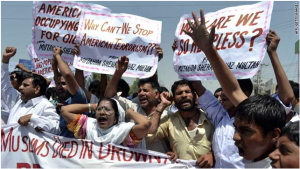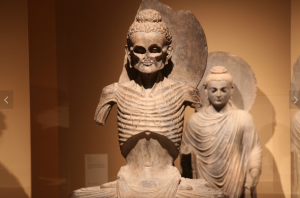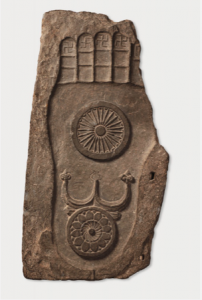News Hour

Controversy surrounded the exhibition exchange began right from its inception. With the selected seventy to seventy-five objects having been displayed in Bonn, Zurich, and Paris only one year earlier, there was a reluctance from the Cultural Ministry of Pakistan to let the exhibition travel again so soon.1Additionally, Anti-American sentiment, on the rise since the killings of Osama bin Laden in May 2011, had thoroughly wreaked havoc upon geopolitical relations between the US and Pakistan, making even the simple exchange of art a monumental undertaking.2The death of major Asia Society advocate Richard C. Holbrooke, the Obama administration’s senior diplomat for Pakistan and a former chairman of the Asia Society, in particular, posed challenges for the exchange.3Of all the drama associated with the planning and delivery of the artifacts, however, the announcement of a delay in the show’s opening by six months after material had been printed and a date set, established the tone for the operation. Despite these initial holdups, though, museum official continued to push forward towards an opening date. Another major issue came about only a month prior to the scheduled opening of the exhibit, when it was revealed that federal authorities in Pakistan’s capital had not “informed the museums in Lahore and Karachi, where the Buddhist objects were kept, of the plan to fly them to New York,” thus forcing the show’s primary curator Melissa Chiu to fly to Lahore in order to persuade the chief minister of the providence to allow the objects to travel.3As Chiu arrived, amidst the chaos of a killed CIA operative and enflamed anti-American sentiment, a hasty meeting was arranged and permission given to for the collection to travel. Even with final arrangements made, however, within three months of the visit, the show continued to be held by an edge, with an American block on travel prohibiting American museum officials from accompanying the selected artifacts back to New York and an escalating crisis emerging in Karachi (the home of a number of the Gandharan objects set to be borrowed).3In the end, the opening of the exhibition could only be guaranteed by the physical arrival of the two planes from Lahore and Karachi in New York in mid-July.
Pakistan’s Perspective

As previously noted, Pakistan had just as many reasons to desire this exchange as the Asia Society did. However, in their case, these desires take on a much more political sheen. With Pakistan’s relationship with the US most frequently described as “strained” and the death of Osama bin Laden spreading chaos thorough a country already plagued with Taliban influence, Pakistan sought this exhibition, in many ways, as an opportunity to showcase to the world their stability and rich history as well as to lay claim to their roots as descendants of Ancient Gandhara.4Though the actual location of Gandhara stretches into what is today Afghanistan, no mention is made to the issue of split heritage in any of the exhibit’s publications or Asia Society sponsored promotions and the firm title The Buddhist Heritage of Pakistan emphasizes the ownership Pakistan claims over these objects.5For all the openness of the exhibit’s critic on Western interference and influence, no voice is given to the provenance debate taking place between these two nations as Pakistan seeks to exert its history and offer clear justification for their (still relatively recent) creation as a country. This nationalist perspective can also be observed in the objects selected for the exhibition. Even with concerns about the objects safety and secure return present throughout the exchange process, the selection of objects is reported to represent the best of the Lahore and Karachi Museums.1Yet, concerns in Pakistan were raised over the selection of certain items, such as the Emaciated Siddhartha, who’s body, “depicted in grim detail at the extremes of fasting and pain,” was not viewed as the appropriate image to be presented in America.2Such images “added fuel to the fire that nearly caused the Asia Society to be denied permission to bring [the seventy objects] out of the country.”5
So That Was a Huge Hassle

According to the reviews of the show, it was almost certainly worth the risks and delays with the exhibition opening to substantial public interest and an overwhelmingly positive reception. Marketed by the Asia Society as “‘a once in a lifetime chance’ to view these works in America,” even the small amount of artifacts acquired did little to dissuade visitors from making the trek to the Asia Society Museum.6Yet, as noted by critic Holland Cotter, the artifacts themselves were “neither dramatic nor grand” despite their turbulent backstory.7Rather “like most museum shows aiming for a big-picture view of a vanished world, it’s a scattering of small effects: precious scraps and remnants.”7What then drew so many to view to the exhibit and what made it so unique? After all, with a collection of hundreds of Gandharan monuments and reliefs only a bus ride away at the Metropolitan Museum of Art, it seems almost ludicrous to put such an inflated importance on seventy items of nearly identical origin. Some may argue that it was the novelty of the traveling exhibition which drew such crowds, but this still does not properly explain the overwhelmingly positive reviews and general air of success surrounding the exhibition. What may, however, is the exhibition’s unique set up, perspective, and careful selection.
- Malik, Sonia. “Buddhist Heritage: Lahore Museum’s Gandhara Artefacts Appreciated in NYC.”The Express Tribune.
- Walsh, Nick Paton and Nasir Habib. “Source: U.S. Departs Pakistan Base.” CNN
- Perlez, Jane. “Long-Delayed Show of Buddhist Art from Pakistan is to Open.” The New York Times.
- “The Buddhist Heritage of Pakistan: Art of Gandhara.” Buddhist Art News.
- Ed. Proser, Adriana. The Buddhist Heritage of Pakistan: Art of Gandhara.
- A.Y. “The Buddhist Heritage of Pakistan: The Beauty of Ancient Globalization.” The Economist.
- Cotter, Holland. “When East Met West Under the Buddha’s Gaze.” The New York Times.